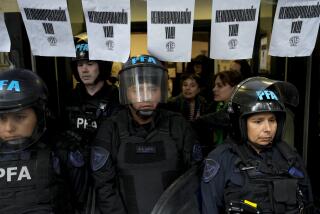Buenos Aires’ 2 Faces: Beauty, Ugliness : The Two Faces of Buenos Aires: From Flowering Spring Beauty to Ugly Shacktowns
- Share via
BUENOS AIRES, Argentina — In the spring, Buenos Aires is a lovely city of flowers and darting sailboats, and an ugly one of shacktowns where hungry children kick soccer balls in dusty lots littered with garbage.
Jacaranda, tipa and ceibo trees are flowering downtown and among the whitewashed houses and cobblestone streets in the comfortable northern suburbs. Every year, the blue, yellow and crimson petals form swirling carpets at the cafes of the Recoleta neighborhood, where afternoon tea remains a tradition.
On the lush green fields of Hurlingham and other clubs, the best polo players in the world thunder past crowds of well-dressed fans.
Sailboats dot the River Plate on weekends. The well-to-do have reserved houses at the shore for summer vacations in January and February.
Outbound jetliners are booked solid beginning with the Christmas holidays, and the most expensive restaurants usually are full. For those with cash in their pockets, Argentina hardly seems mired in one of its worst recessions.
Life is different in Azul, one of the villas miserias --misery villages--that have become too numerous to remain hidden.
Fifteen minutes by car from downtown beside the foul Riachuelo river, Azul is a collection of one-story metal and concrete-block shacks around a field of hard-packed earth where residents throw garbage and the children play.
Many of the shacks have no running water, electricity or telephone. The men don’t have jobs, their children drop out of school, and hardly anyone has enough to eat.
“I never had a gun in my life; now I do,” Ana Montiel, 36, said on a breezy morning at a day-care center operated by UNICEF, the U.N. Children’s Fund.
There always have been very rich and very poor Argentines. What made the country different was its middle class, once the largest south of the Rio Grande.
Now, the middle class is being compressed by a severe recession that follows a decade of economic stagnation and 15 years of high inflation. Real salaries have fallen below 1980s’ levels. Nearly one adult in five lacks a full-time job and the minimum monthly wage of 700,000 australs ($127) doesn’t buy enough food to last a frugal family of four half that time.
The recession, and a government austerity program that is cutting thousands of jobs from the public payroll, have been devastating for the poor.
Argentina was among the world’s most affluent nations during the first half of this century. Now, UNICEF says, nearly 25% of its families have serious deficiencies in housing, food, health or sanitary conditions.
An estimated 20,000 children died from malnutrition or illness brought on by poor sanitary conditions last year and “70% of those deaths were preventable,” said Eduardo Bustelo, UNICEF director in Argentina.
The government is aware of the problems, but seems helpless.
“In the north of Argentina, diseases that had been eliminated have returned, like malaria and chagas,” acknowledged Moises Ikonicoff, director of the Economy Ministry’s planning office.
Making things better will require “many years of effort and sacrifice,” he said.
Upper class “portenos,” or port-dwellers, as residents of Buenos Aires are called, don’t have to visit Azul or other shantytowns to see their suffering countrymen.
When night falls, youths from slums behind the two central railroad terminals and under a major elevated highway scrounge in garbage cans for cardboard, newspapers and bottles to sell.
Children sleep in doorways and parks, ask for handouts in restaurants and put bookmarks with religious or inspirational sayings on the knees of train and subway commuters, hoping for loose change in return.
Civic boosters note legitimately that the situation is not nearly so desperate as in Rio de Janeiro, Brazil, or Lima, Peru.
For a city that prides itself on Parisian architecture and counts among its achievements the continent’s first subway, skyscraper and biggest bank, that is small comfort.
More to Read
Sign up for Essential California
The most important California stories and recommendations in your inbox every morning.
You may occasionally receive promotional content from the Los Angeles Times.










